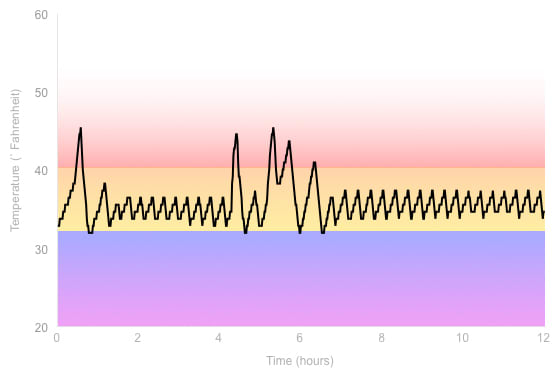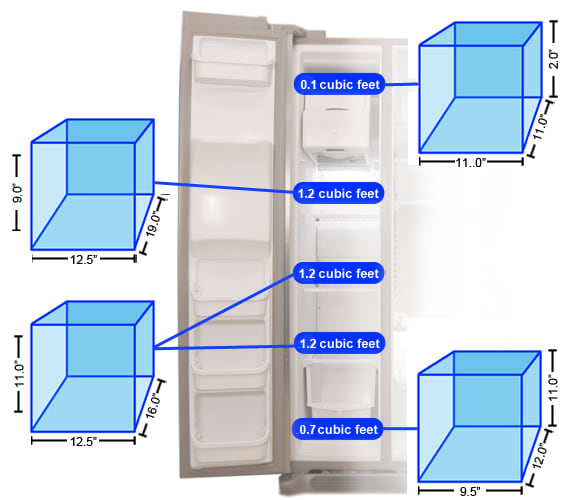Pros
Cons
Introduction
One of the most exciting product lines that we saw included the Haier A2FE735CXJ, a member of the second generation of what they call “3D” fridges. Now, before you start scratching your heads and imagining projections of already-three-dimensional objects shooting out into the middle of your kitchen, let us clarify: “3D” stands for “3 Doors.” Yeah, you read that right. It's groan-inducing, but that's marketing for you. Bad names aside, Haier was apparently the first company to come up with a refrigerator design that had not one pull-out freezer drawer, but two: the first generation of these products came out three years ago, and the second generation (of which this product is a member) was just released in Europe at the beginning of this past July with an average retail price of €900 (approximately $1132).
The guiding principle behind the new generation of fridges centers on the effects of two new pieces of technology: Haier's digital inverter compressor and the five sensors used to monitor internal temperatures.
Front
{{section_header}}{{section.name}}{{/section_header}}
Unlike many of the other models on display at the Haier booth, this one just had a basic stainless steel finish. The innovative feature is the fact that there are three doors: one for the fridge, and two smaller pull-out doors for the freezer. Hence the name 3D, which stands for 3 Doors. Many European fridges, called larder fridges in some countries, have just one large door and a small freezer compartment accessible through a flap inside the fridge, essentially a taller version of an American mini-fridge. Without the extra standard door or second temperature control, It's more economical to build. This is less of an innovation in America, where we haven't really had fridges with that layout since FDR, but it's worth mentioning as it was pioneered by Haier in other appliance markets outside of our own.

Controls are located entirely on the outside of the fridge. Using the touchscreen located on the fridge door, you can adjust the temperatures of not only the fridge and freezer, but also the "My Zone" drawer, as well, which is discussed in further detail below.

While the freezer drawers have indented lips on the front that you pull on, the fridge itself has a recessed handle. There's one located on each side, which means the door is reversible to suit your kitchen.

Interior
{{section_header}}{{section.name}}{{/section_header}}
The inside of the appliance uses blue-tinted LED lighting to cast a glow over the interior that gives this fridge a decidedly modern look. Shelves use a combination of plastic and glass to make things look sleek and cutting edge.

The interior of the CDWT980VSS.
The fridge has four standard shelves and a Fruits and Vegetables drawer, in addition to some interesting other features. Most beverage racks available on American fridges are removable; the {{product.brand.name}} circumvents this by making one that can fold up, allowing for unobtrusive storage when not needed that doesn't require consumers to find a place for it outside the fridge.

At the bottom of the compartment, you'll see the My Zone drawer. This is more than just a traditional chill drawer; Haier representatives explained that this can be set to temperatures ranging from 0 to 5 degrees Celsius, or 32 to 41 degrees Fahrenheit. Promotional material went on to elaborate that it's ideally used for one of three purposes: defrosting, chilling, and quick cooling. You can read more about these different features in the Vegetable Drawer section of this review's Performance page.

The freezer is pretty basic, all things considered. It consists of two pull-out drawers that come with removable shallow trays, allowing for additionally segregated storage. We usually see this sort of thing on both bottom freezers and French door models, except we have just the one pull-out drawer with a separate shelf on its own track inside the compartment. On one hand, the two exterior handles adds some visual clutter, and we have to wonder how much potentially usable space is being taken up by having a completely separate door. On the other hand, having the option of only opening half the freezer compartment means less cold air escapes, which could result in some pretty substantial savings pertaining to energy efficiency.

Back
{{section_header}}{{section.name}}{{/section_header}}
The back of the fridge wasn't visible, though we don't imagine there's anything very different back there compared to what's usually seen. The lack of water filter and ice maker means there won't be any hoses to transport water from one point of the fridge to another.

Sides
{{section_header}}{{section.name}}{{/section_header}}
The sides of the fridge had a matte finish that matches the front. Nothing terribly unusual here, either. The product itself was inset into the display podium, so a full picture wasn't possible.

Olympus SZ-31MR iHS side views
Fridge Temperature
{{section_header}}{{section.name}}{{/section_header}}
Haier and Samsung both displayed innovations in compressor technology, and you can read more about their similarities and differences here. What it comes down to is that temperatures fluctuate over time more than anyone wants. The idea behind the digital converter is that it's always on instead of going through an "on/off" cycle every few hours. This means the compressor won't have to work as hard, resulting in up to 60 percent energy savings according to the Haier representative that we spoke to, and will reduce the temperature fluctuation by half.


What Haier's has done that's really interesting is develop a method of ventilating the fridge that keeps air temperatures even throughout. Anyone who has read one of our articles, especially one detailing a larger side-by-side model, knows that almost every fridge suffers from a change in temperature from the top of a compartment to the bottom. Haier has installed multiple vents inside the fridge so that air that has been cooled to an even temperature is being pumped throughout the fridge as opposed to just from the top or bottom, effectively removing the problem of temperature shift. It keeps air cooled evenly throughout by employing five different temperature sensors spread across the entire machine—three in the fridge and two in the freezer—in order to measure the temperature in different zones, making adjustments where necessary. Adding some icing to the chilled cake is the fact that the vents take up hardly any space: some line the thin LED light located at the back of the fridge compartment, with individual ones located in the vegetable and My Zone drawers, as well. The larger number of vents means each one works less, so they can afford to be smaller.
Vegetable Drawer
{{section_header}}{{section.name}}{{/section_header}}
Haier representatives were particularly proud of the My Zone drawer. It may just be a glorified chill drawer, but its promised versatility lead us to believe that it may actually be more useful than what consumers already have. It allows you to change the temperature from 0 to 5 degrees Celsius, or 32 to 45 degrees Fahrenheit. The three distinct uses touted by the promotional material consisted of defrosting, chilling, and quick cooling.

Defrosting is pretty self-explanatory: you take frozen products that you'd like to eat later in the day, put it in the drawer before you go off to work. By the time you're ready to cook, you have thawed meat or fish. Chilling also deals with meat and fish, or any similarly delicate food item you can think of.
Poor freezing runs the risk of reducing the flavor and texture of items like meats and fish, and can also lower their nutritional value. If you have some food that you know you're going to eat within a day or two, but don't want to deal with the hassle of freezing it, you can chill it in the My Zone drawer. This well keep it in better condition than just leaving it in the fridge without any of the damage caused by freezing.
The last recommended use of My Zone is for quick cooling items. The example given to use by a Haier representative involved something that could easily happen during a party or barbeque. People have a habit of showing up to large gatherings at different times. If you don't have room in your fridge for all the drinks of cooler treats you'd like to distribute, you can leave them out and stick them in the My Zone drawer when your guests arrive. They'll cool off faster than they would if you just stuck them in the fridge, and glasses or cutlery won't be damaged since they're not going in the freezer. It's a similar principle behind LG's as-yet-unreleased Blast Chiller, though on a decidedly more practical scale.

Usable Space
{{section_header}}{{section.name}}{{/section_header}}
One of the innovations being touted by Haier at the IFA convention was its implementation of space-age technology to improve upon fridge insulation. Using a new material about which we weren't able to get very many details, the amount of space taken up by fridge walls has been reduced, offering an additional 15 percent of space overall. The exterior of the fridge will remain the same, but the inside is theoretically larger. We measure usable space by taking into account room that's taken up by shelves, lights, drawers, and other obtrusive objects, so whether the 15 percent figure is completely accurate remains to be seen. It is fairly, evident, though, that the fridge walls are smaller, so you're definitely getting an overall increase.




In case you missed us mentioning this before, the whole point of "3D" design is that the products have "3 Doors." Two of those three doors serve as pull-out drawers located in the freezer. Think of traditional bottom freezers or French door models in America, and you have the basic idea: we typically have fridges designed with one pull-out drawer that houses one large bucket with a second drawer inside on its own separate track. The {{product.model}} takes that principal and simple gives the independent interior drawer its own door. While this may result in superior energy efficiency—open a smaller portion of the freezer means less cold air needs to be replaced when you close the door again—it could potentially mean less actual storage space proportional to the size of the appliance.


Below are the manufacturers own figures for capacity, and our own measurements for usable capacity. The manufacturers figures do not take account of the shelves, drawers and other removable features, but our measurements do account for the space these take up.
Conclusion
{{product.vanity}}
Between the new digital converter compressor technology, the space-age insulation, and the five sensor temperature monitoring system, the {{product.name}} is a really exciting fridge that offers some fascinating innovations all in one package. We estimate the value of this product at bout $1132 based on the Google currency converter and a Haier representatives statement that this retails for about €900. We'd love to get one of these into our labs to test it, because if all the new elements that are being incorporated into the second generation of 3D fridges actually work, this is shaping up to be a fantastic product. That brings us to the one major downside, however.
There really wasn't anything available in the Haier exhibit that's going to be available in American any time soon. For now, we're stuck with budget imports like the Haier RRTW18VABW. It did a decent job, but it's a decidedly low-end fridge that paled in comparison to what we saw at IFA; it's biggest draw is its unusually low price. If the manufacturer decides to start marketing this technology in appliances suitable for the American market, however, you can bet that the folks at companies with a long-established presence here are going to start sweating. The only thing really lacking is size: most of the fridges we saw , including the {{product.model}}, were either side-by-side counter depths, or tall and thin (what we would call) compacts very similar to the recently-reviewed Summit CP171SS. They may look exotic, but that design is actually quite common in the European market, where most households have smaller appliances in order to save on valuable kitchen and apartment space…Wait, doesn’t that sound just like what people who live in small city apartments or studios try to do here? Hmm…I smell a potential market base.
Meet the tester
Matthew is a native of Brockton, Mass., and a graduate of Northeastern University, where he earned a degree in English and Theatre. He has also studied at the Gaiety School of Acting in Dublin, Ireland, and spends time pursuing a performance career in the greater Boston and Cambridge area.
Checking our work.
Our team is here to help you buy the best stuff and love what you own. Our writers, editors, and experts obsess over the products we cover to make sure you're confident and satisfied. Have a different opinion about something we recommend? Email us and we'll compare notes.
Shoot us an email